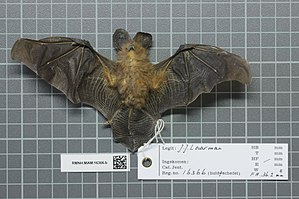Bate slit nose
| Bate slit nose | ||||||||||||
|---|---|---|---|---|---|---|---|---|---|---|---|---|

Preparation in the Naturalis Biodiversity Center |
||||||||||||
| Systematics | ||||||||||||
|
||||||||||||
| Scientific name | ||||||||||||
| Nycteris arge | ||||||||||||
| Thomas , 1903 |
The Bate-Schlitznase ( Nycteris arge ), is a bat species of the genus of the Schlitznasen ( Nycteris ), which occurs in West and Central Africa .
description
The Bate slit nose is a small bat species weighing around 11 g and a forearm length averaging 4.1 cm. Outwardly, it resembles the Dja slit nose , which is slightly larger and heavier than the Bate slit nose. The fur is dark brown above and below. The wings are also dark brown and hairless. The ears are wide and rounded, and the outer edge of the tragus is concave halfway along its length. As with other slit noses, the face above the muzzle appears to be divided into two by a longitudinal furrow.
distribution
The bate slit nose is widespread in West and Central Africa. Their distribution area extends from Sierra Leone in West Africa across the Congo Basin to western Uganda , southern South Sudan and northern Tanzania .
Way of life
The Bate slit nose occurs mainly in rainforests, tree hollows serve as quarters, the entrance of which is close to the stump. Caves are also used as quarters. The species is mostly found individually or in smaller family groups.
Etymology & Research History
It is named after George Latimer Bates , who collected the type specimen in Cameroon that was first described by Oldfield Thomas in 1903.
Danger
The IUCN classifies the species as not endangered (“least concern”) due to its large distribution area and its frequency.
literature
- Ara Monadjem , Peter John Taylor , FPD (Woody) Cotterill & M. Corrie Schoeman: Bats of Southern and Central Africa: A Biogeographic and Taxonomic Synthesis . 1st edition. Wits University Press, Pretoria 2010, ISBN 978-1-86814-508-9 .
Web links
- Nycteris arge in the Integrated Taxonomic Information System (ITIS). Retrieved May 23, 2017.
- Nycteris arge inthe IUCN Red List of Threatened Species 2016.3. Listed by: J. Fahr et al., 2008. Retrieved May 23, 2017.
Individual evidence
- ^ Theodor CH Cole: Dictionary of Mammal Names - Dictionary of Mammal Names . 1st edition. Springer-Verlag, Berlin Heidelberg 2015, ISBN 978-3-662-46269-0 .
- ↑ a b Monadjem et al. (2010). Pp. 280-281
- ↑ a b Victor Van Cakenberghe & Ernest CJ Seamark (eds.): ACR. 2016. African Chiroptera Report 2016. African Bats . 2016, ISSN 1990-6471 , p. 328-329 .
- ↑ Oldfield Thomas: Three new Bats from the Cameroons, discovered by Mr. GL Bates . In: Ann. Mag. Nat. Hist. tape 12 , no. 7 , 1903, pp. 633-634 ( biodiversitylibrary.org ).
- ↑ Nycteris arge in the IUCN Red List of Threatened Species 2016.3. Listed by: J. Fahr et al., 2008. Retrieved May 23, 2017.